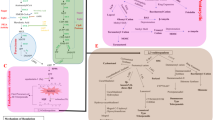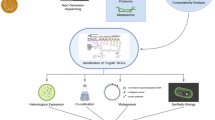Abstract
3-Ketosteroid-Δ1-dehydrogenases (KstDs [EC 1.3.99.4]) catalyze the Δ1-dehydrogenation of steroids and are a class of important enzymes for steroid biotransformations. In this study, we cloned 12 putative KstD-encoding (kstd) genes from both fungal and Gram-positive microorganisms and attempted to overproduce the recombinant proteins in E. coli BL21(DE3). Five successful recombinant enzymes catalyzed the Δ1-desaturation of a variety of steroidal compounds such as 4-androstene-3,17-dione (AD), 9α-hydroxy-4-androstene-3,17-dione (9-OH-AD), hydrocortisone, cortisone, and cortexolone. However, the substrate specificity and catalytic efficiency of the enzymes differ depending on their sources. The purified KstD from Mycobacterium smegmatis mc2155 (MsKstD1) displayed high catalytic efficiency toward hydrocortisone, progesterone, and 9-OH-AD, where it had the highest affinity (K m 36.9 ± 4.6 μM) toward 9-OH-AD. On the other hand, the KstD from Rhodococcus erythropolis WY 1406 (ReKstD) exhibited high catalytic efficiency toward androst-4,9(11)-diene-3,17-dione (Diene), 21-acetoxy-pregna-4,9(11),16-triene-3,20-dione (Triene), and cortexolone, where in all three cases the K m values (12.3 to 17.8 μM) were 2.5–4-fold lower than that toward hydrocortisone (46.3 μM). For both enzymes, AD was a good substrate although ReKstD had a 3-fold higher affinity than MsKstD1. Reaction conditions were optimized for the biotransformation of AD or hydrocortisone in terms of pH, temperature, and effects of hydrogen peroxide, solvent, and electron acceptor. For the biotransformation of hydrocortisone with 20 g/L wet resting E. coli cells harboring MsKstD1 enzyme, the yield of prednisolone was about 90% within 3 h at the substrate concentration of 6 g/L, demonstrating the application potential of the newly cloned KstDs.







Similar content being viewed by others
References
Adham NZ, El-Hady AA, Naim N (2003) Biochemical studies on the microbial Δ1-dehydrogenation of cortisol by Pseudomonas fluorescens. Process Biochem 38(6):897–902
Arinbasarova AGM, Akimenko VK, Koshcheyenko KA, Skryabin GK (1985) Redox reactions in hydrocortisone transformation by Arthrobacter globiformis cells. J Steroid Biochem 23:307–312
Bhatti HN, Khera RA (2012) Biological transformations of steroidal compounds: a review. Steroids 77(12):1267–1290
Bredehoft M, Baginski R, Parr MK, Thevis M, Schanzer W (2012) Investigations of the microbial transformation of cortisol to prednisolone in urine samples. J Steroid Biochem Mol Biol 129(1–2):54–60
Carballeira JD, Quezada MA, Hoyos P, Simeó Y, Hernaiz MJ, Alcantara AR, Sinisterra JV (2009) Microbial cells as catalysts for stereoselective red-ox reactions. Biotechnol Adv 27(6):686–714
Chen K, Liu C, Deng L, Xu G (2010) A practical Δ1-dehydrogenation of Δ4-3-keto-steroids with DDQ in the presence of TBDMSCl at room temperature. Steroids 75(7):513–516
Chen MM, Wang FQ, Lin LC, Yao K, Wei DZ (2012) Characterization and application of fusidane antibiotic biosynethsis enzyme 3-ketosteroid-Δ1-dehydrogenase in steroid transformation. Appl Microbiol Biotechnol 96(1):133–142
Chiang YR, Ismail W, Gallien S, Heintz D, Van Dorsselaer A, Fuchs G (2008) Cholest-4-en-3-one-Δ1-dehydrogenase, a flavoprotein catalyzing the second step in anoxic cholesterol metabolism. Appl Environ Microbiol 74(1):107–113
Choi KP, Molnár I, Yamashita M, Murooka Y (1995a) Purification and characterization of the 3-ketosteroid-Δ1-dehydrogenase of Arthrobacter simplex produced in Streptomyces liuidans. J Biochem 117:1043–1049
Choi KP, Murooka Y, Molnár I (1995b) Secretory overproduction of Arthrobacter simplex 3-ketosteroid Δ1-dehydrogenase by Streptomyces lividans with a multi-copy shuttle vector. Appl Microbiol Biotechnol 43:1044–1049
Donova MV (2007) Transformation of steroids by actinobacteria: a review. Appl Biochem Microbiol 43(1):1–14
Donova MV, Egorova OV (2012) Microbial steroid transformations: current state and prospects. Appl Microbiol Biotechnol 94(6):1423–1447
El-Hadi AA (2003) Production of prednisolone by Bacillus pumilus E601 cells incorporated in radiation induced poly(vinyl alcohol g-2 hydroxyethylmethacrylate) cryogels. Process Biochem 38(12):1653–1657
Fernandes P, Cruz A, Angelova B, Pinheiro HM, Cabral JMS (2003) Microbial conversion of steroid compounds: recent developments. Enzyme Microb Tech 32(6):688–705
Fokina VV, Donova MV (2003) 21-Acetoxy-pregna-4(5),9(11),16(17)- triene-21-ol-3,20-dione conversion by Nocardioides simplex VKM ac-2033D. J Steroid Biochem Mol Biol 87(4–5):319–325
Fokina VV, Sukhodolskaya GV, Baskunov BP, Turchin KF, Grinenko GS, Donova MV (2003) Microbial conversion of pregna-4,9(11)-diene-17α,21- diol-3,20-dione acetates by Nocardioides simplex VKM Ac-2033D. Steroids 68(5):415–421
van der Geize R, Hessels GI, van Gerwen R, Vrijbloed JW, van der Meijden P, Dijkhuizen L (2000) Targeted disruption of the KstD gene encoding a 3-ketosteroid Δ1-dehydrogenase isoenzyme of Rhodococcus erythropolis strain SQ1. Appl Environ Microbiol 66(5):2029–2036
van der Geize R, Hessels GI, Dijkhuizen L (2002) Molecular and functional characterization of the kstD2 gene of Rhodococcus erythropolis SQ1 encoding a second 3-ketosteroid Δ1-dehydrogenase isoenzyme. Microbiology 148(10):3285–3292
Grote A, Hiller K, Scheer M, Munch R, Nortemann B, Hempel DC, Jahn D (2005) JCat: a novel tool to adapt codon usage of a target gene to its potential expression host. Nucleic Acids Res 33:526–531
de las Heras LF, van der Geize R, Drzyzga O, Perera J, Navarro Llorens JM (2012) Molecular characterization of three 3-ketosteroid-Δ1-dehydrogenase isoenzymes of Rhodococcus ruber strain Chol-4. J Steroid Biochem Mol Biol 132(3–5):271–281
Itagaki E, Hatta T, Wakabayashi T, Suzuki K (1990a) Spectral properties of 3-ketosteroid-Δ1-dehydrogenase from Nocardia corallina. Biochim Biophys Acta 1040:281–286
Itagaki E, Wakabayashi T, Hatta T (1990b) Purification and characterization of 3-ketosteroid-Δ1-dehydrogenase from Nocardia corallina. Biochim Biophys Acta 1038:60–67
Jing Y, Xu CG, Ding K, Lin JR, Jin RH, Tian WS (2010) Protecting group effect on the 1,2-dehydrogenation of 19-hydroxysteroids: a highly efficient protocol for the synthesis of estrogens. Tetrahedron Lett 51(24):3242–3245
Kaul R, Mattiasson B (1986) Extractive bioconversion in aqueous two-phase systems. Appl Microbiol Biotechnol 24(4):259–265
Knol J, Bodewits K, Hessels GI, Dijkhuizen L, van der Geize R (2008) 3-Keto-5α-steroid Δ1-dehydrogenase from Rhodococcus erythropolis SQ1 and its orthologue in Mycobacterium tuberculosis H37Rv are highly specific enzymes that function in cholesterol catabolism. Biochem J 410(2):339–346
Marcos-Escribano A, Bermejo FA, Bonde-Larsen AL, Retuerto JI, Sierra IH (2009) 1,2-Dehydrogenation of steroidal 6-methylene derivatives. Synthesis of exemestane. Tetrahedron 65(36):7587–7590
Morii S, Fujii C, Miyoshi T, Iwami M, Itagaki E (1998) 3-Ketosteroid-Δ1-dehydrogenase of Rhodococcus rhodochrous: sequencing of the genomic DNA and hyperexpression, purification, and characterization of the recombinant enzyme. J Biochem 124(5):1026–1032
Plesiat P, Grandguillot M, Harayama S, Vragar S, Michel-Briand Y (1991) Cloning, sequencing, and expression of the Pseudomonas testosteroni gene encoding 3-oxosteroid Δ1-dehydrogenase. J Bacteriol 173(22):7219
Rohman A, van Oosterwijk N, Thunnissen AM, Dijkstra BW (2013) Crystal structure and site-directed mutagenesis of 3-ketosteroid Δ1-dehydrogenase from Rhodococcus erythropolis SQ1 explain its catalytic mechanism. J Biol Chem 288(49):35559–35568
Sukhodolskaya GV, Nikolayeva VM, Khomutov SM, Donova MV (2007) Steroid-1 -dehydrogenase of Mycobacterium sp. VKM Ac-1817D strain producing 9α-hydroxy-androst-4-ene-3,17-dione from sitosterol. Appl Microbiol Biotechnol 74(4):867–873
Vlahov R, Pramatarova V, Spassov G, Suchodolskaya GV, Koshcheenko KA (1990) Transformation of microcrystalline hydrocortisone by free and immobilized cells of Arthrobacter simplex. Appl Microbiol Biotechnol 33(2):172–175
Wang Y, Li J, Wu Q, Zhu D (2013) Microbial stereospecific reduction of 3-quinuclidinone with newly isolated Nocardia sp. and Rhodococcus erythropolis. J Mol Catal B Enzym 88:14–19
Wei W, Wang FQ, Fan SY, Wei DZ (2010) Inactivation and augmentation of the primary 3-ketosteroid-Δ1-dehydrogenase in Mycobacterium neoaurum NwIB-01: biotransformation of soybean phytosterols to 4-androstene- 3,17-dione or 1,4-androstadiene-3,17-dione. Appl Environ Microbiol 76(13):4578–4582
Wei W, Fan SY, Wang FQ, Wei DZ (2014) Accumulation of androstadiene-dione by overexpression of heterologous 3-ketosteroid Δ1-dehydrogenase in Mycobacterium neoaurum NwIB-01. World J Microb Biot 30(7):1947–1954
Yao K, Xu LQ, Wang FQ, Wei DZ (2014) Characterization and engineering of 3-ketosteroid-Δ1-dehydrogenase and 3-ketosteroid-9α-hydroxylase in Mycobacterium neoaurum ATCC 25795 to produce 9α-hydroxy-4-androstene-3,17-dione through the catabolism of sterols. Metab Eng 24:181–191
Zhang H, Tian Y, Wang J, Li Y, Wang H, Mao S, Liu X, Wang C, Bie S, Lu F (2013) Construction of engineered Arthrobacter simplex with improved performance for cortisone acetate biotransformation. Appl Microbiol Biotechnol 97(21):9503–9514
Acknowledgements
This work was financially supported by the STS Program of Chinese Academy of Sciences (KFJ-SW-STS-164) and the National High Technology Research and Development Program (“863”Program) of China (Nos. 02011AA02A211). The authors thank the sponsorship from Zhejiang Xianju Junye Pharmaceutical Co., Ltd. (Zhejiang, China), and greatly appreciate Professor Peter Lau at the same institute for his help and constructive suggestions on this manuscript.
Author information
Authors and Affiliations
Corresponding authors
Ethics declarations
This article does not contain any studies with human participants or animals performed by the authors.
Conflict of interest
The authors declare that they have no conflict of interest.
Electronic supplementary material
ESM 1
(PDF 354 kb)
Rights and permissions
About this article
Cite this article
Wang, X., Feng, J., Zhang, D. et al. Characterization of new recombinant 3-ketosteroid-Δ1-dehydrogenases for the biotransformation of steroids. Appl Microbiol Biotechnol 101, 6049–6060 (2017). https://doi.org/10.1007/s00253-017-8378-2
Received:
Accepted:
Published:
Issue Date:
DOI: https://doi.org/10.1007/s00253-017-8378-2




